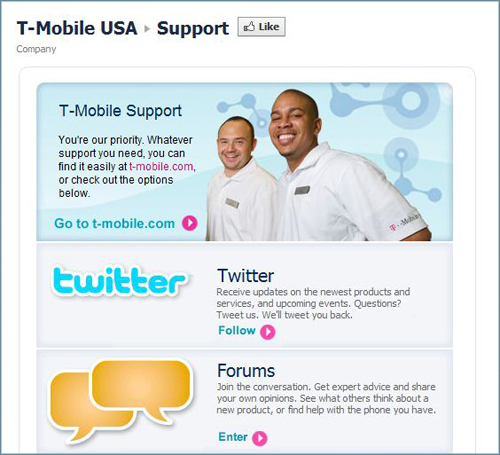|
|

article page
| 1
| 2
| 3
| 4
| 5Protect That Trademark
While it would not make sense to try and take on a hundred hate groups who are misusing a logo – that only plays into their hands – it may make sense to have a corporate-level dialogue with Facebook about it. That discussion might go something like this, “hey guys, we have a few smartphone users over here who visit your site through our network; you mind helping us out with unauthorized use of our intellectual property?”
Further, it certainly would
make sense for any company that leverages customer-facing resellers and franchisees to create clear policies and protocols to govern branding, marketing, and customer interaction over social media channels. This is all about protecting the end to end customer experience, and the need to defend the trademark.
|
|
Where customer service has clearly gravitated to social networking, those responsible for managing retail channels haven’t. |
|


the country group.”
For those who would scoff at this as preposterous and suggest that large companies have better things to do than worry about people misusing their trademarks on Facebook, Dr. Brand points to Coca-Cola as an example. “Coke has a team of people to go to restaurants that serve colas other than Coke…If the service staff doesn't say, "Is Pepsi, OK?" they make a note of it and a lawyer letter goes out.” Disney is another company that is known to protect its trademarks with consistent aggression in a similar way.
The bottom line for operators is that
social media is growing in importance in
|
|
|
|
|

Dr. Russell Brand, CEO and Founder of
Responsible Solutions, is an authority
on online technology and advises large
companies on intellectual property
matters. He explains that “a company
that fails to protect its trademark can
lose the rights to it.” Dr.Brand surmises
that while major companies tend to
“have complete teams to deal with the
printed matter issues, point of service,
etc; they don’t have a team to deal
with the social media and web
equivalents.” He adds that while there
is little case law to define “safe haven
defensive practices” the “intrinsic risks”
regarding trademark abandonment
“are the same; they risk complete and
unrecoverable loss of the trademark.”
Further, this doesn’t mean just losing
the right to defend the company’s
trademark in social media channels, but
rather “losing it in any one advertising
form loses it in all forms; at least within
|
|

regards to its contribution to the
overall customer experience, to cost
reduction, and in driving uptake of
online self-service. Though we are in
the earliest stages, there clearly are
lessons and management practices
that have been developed across more
traditional customer-facing channels
that are not yet being applied to social
media. Operators deserve credit for
trying to be creative, if not innovative,
in establishing teams dedicating to
managing customer interactions on
social media sites. Though the maturity
level and adoption rate remain
relatively low, as with any other new
business practice – from revenue
assurance to paperless billing – it
makes sense that it will simply take
time for operators and customers to
adjust to the medium, its benefits, and
its risks.
article page
| 1
| 2
| 3
| 4
| 5 |
|
|





